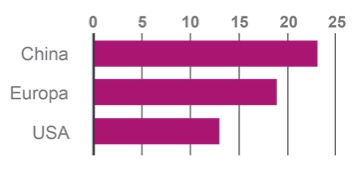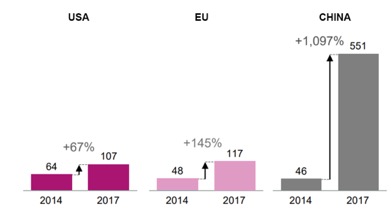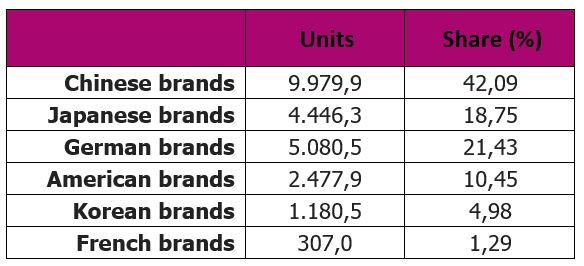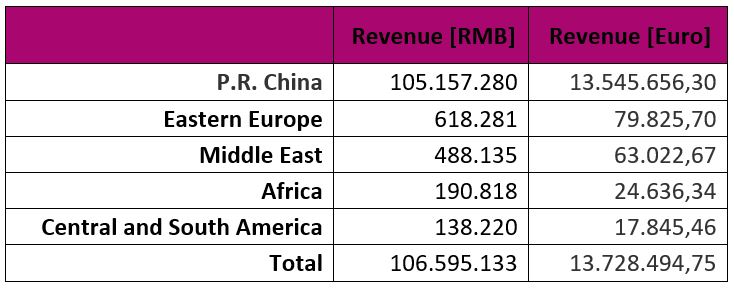China: The new global automotive force
The rise of China is often discussed in Europe and recognised. How dominate the power of China really is in the automotive and mobility sector is described in this blog. This blog is an expanded extract of a study commissioned by the Austrian Ministry for Transport, Innovation and Technology and the Federation of the Austrian economy [1] .
The automotive industry is a European success story. Over 13 million people work for the automotive economy and generate 6% of total tax revenues in the EU-15 states [2] (Belgium, Denmark, Germany, Finland, France, Greece, Great Britain, Ireland, Italy, Luxembourg, the Netherlands, Austria, Portugal, Sweden, Spain).
However, this position is in danger: in addition to new business models and trends, China’s rise will become increasingly challenging.
McKinsey predicts that this position of strength and prosperity is in danger. China’s recently dominant position in the automotive industry and new business models such as sharing and autonomous driving require very different skills than producing excellent vehicles. [2] Data-based services and shared mobility are cited as examples, which are expected to generate 25% of industrial sales in 2030; in 2018, the figure was 0,2%. [2]
China dominates vehicle production
- China is the world market leader in vehicle production. [3]
- China is the world market leader in electric vehicle production. [3]
- China is the world market leader in vehicle battery production. [4]
The Chinese government’s joint venture strategy has achieved many of its goals. The cars and batteries in Beijing carry foreign badges but are manufactured in China. The country produced around 23 million passenger cars in 2018, clearly outperforming Europe and North America, illustrated in [3, 5]
Figure 1: Passenger car production in China, Europe and USA in 2018, in million units

Source: Own illustration based on [5]
In 2018, a battery capacity of 220,5 GWh was produced worldwide. 134,5 GWh of which were produced in China. In 2023, it is predicted that 7 out of 10 of the world’s largest battery systems giga factories will be located in China. [4]
Chinese electric vehicle start-ups are also leaders in the competition for investment capital. According to Pitchbook Data, more than $14,5 Mrd. Dollar was invested between 2014 and the first quarter of 2019 [6], compared to just over $6 Mrd. Dollar in electric vehicle start-ups in the US over the same period. However, the venture capital investments into China’s EV start-ups has dropped nearly 90% in 2019. From 6 Mrd. Dollar in the middle of June in 2018 to 783 Mio. Dollar in the same time period 2019
China dominates the vehicle market
- China is the world’s largest vehicle market. [7]
- China is the world’s largest electric vehicle market. [7]
- China is the world’s largest ride-hailing country. [7]
China’s rise to become the world’s largest automobile market progressed rapidly. Sales of 8 million new vehicles in 2007 peaked at 24 million in 2017 and 23,2 million in 2018. [8] Most of these sales were supplied by known foreign OEMs. In 2018, the Chinese market was responsible for around 40% of all worldwide sales of the Volkswagen AG [9].
The volume of newly registered electric vehicles in China increased by more than 100% each year from 2013 to 2018. [7] In 2018, 1,1 million electric vehicles (BEV + PHEV) were sold in China, 75% of which were battery-powered electric cars [10]. Figure 2 compares new BEV registrations in the three main markets USA, Europe and China from 2014 to 2017.
Figure 2: New registrations of battery-powered electric vehicles in the USA, EU and China, in thousands

Source: Own illustration based on [2]
To set these figures in relation to the total passenger car registrations in 2014 and 2017, Table 1 illustrates the numbers.
Table 1: New vehicle registrations separated in total and BEVs in the USA, EU and China, in thousands

Source: Own illustration based on [11, 12]
In addition, structural changes are also emerging in the Chinese automotive market. With over 405,1 million customers [13] and approximately 35 million daily journeys [7] in 2018, China overtakes the USA with 58,4 million users [14] and is responsible for almost half of the 70 million daily journeys [7] worldwide.Source: Own illustration based on [11, 12]
Conclusion
China’s market and manufacturing dominance will contribute to the fact that supply chains for electric vehicles will settle in China and the dominance can be further expanded.
At the same time, China is planning to push ahead with the introduction of hydrogen vehicles to become a leader in this field as well, with an 11 Mrd. Euro subsidy in 2018 for fuel cell research and the hydrogen energy economy. [15, 16]
The quality and design of local Chinese automobile manufacturers is also improving continuously. Experts estimate that by 2020 more local vehicle brands will be sold in China than foreign brands. [5] Table 2 shows the passenger car sales in china ranked by the country brands. Approximately 42% of all vehicles sold in China were domestic brands.
Table 2: Passenger car sales in China ranked by country/brand 2018, in thousands

Source: Own illustration based on [17]
The particularly high sales level of German vehicle manufacturers in China has led to a strong dependence on this market. If the business in China deteriorates, this will have a substantial impact on sales figures and thus also indirectly on the Austrian automotive economy. Table 3 shows the dependency of the German vehicle manufactures for the Chinese Markets. In 2017 Volkswagen sold 41,6% BMW 24,15% and Daimler 24,7% of their vehicles in China.
Table 3: Global passenger car sales of German automotive brands in 2017, in thousands

Source: Own illustration based on [18–20]
Some Chinese companies are currently validating exports to the West: the automobile manufacturers Geely, GAC and Great Wall are particularly ambitious in this project but have been slowed down by the American tariffs. Geely, the most ambitious Chinese automobile manufacturer in this respect, bought Volvo from Ford in 2010 and acquired 9,7% of Daimler AG in 2018, making it the largest single shareholder. [5] In 2018 Geely exported globally 27.768 units that represents 1.9% of the Group’s total sales volume. [21] Table 4 shows the revenue Geely made generated in 2018.
Table 4: Geely global revenue ranked by country, in thousands, converted into EURO (1RMB = 0,13 Euro)

Source: Own illustration based on [21]
For Austria: Even if China is only ranked on the 15th place on the Austrian automotive industry exports, the important of that market shall not be underestimated. China as the biggest automobile market in the world influences the German vehicle manufacturers. As the German automotive market accounts for approximately on third of the total exports of the Austrian automotive industry Austria is indirectly dependent from China and the decisions that are made by the Chinese government.
Authors: Dr. Hans-Peter Kleebinder, Michael Semmer
Literature



